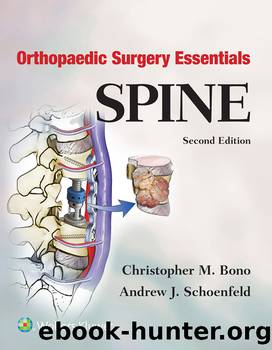Orthopaedic Surgery Essentials: Spine by Bono Christopher M.;Schoenfeld Andrew J.;

Author:Bono, Christopher M.;Schoenfeld, Andrew J.; [Bono, Christopher M.; Schoenfeld, Andrew J.]
Language: eng
Format: epub
ISBN: 5122318
Publisher: Wolters Kluwer
Published: 2017-09-15T00:00:00+00:00
Figure 22.5 Boston style thoracolumbosacral orthosis for scoliosis management.
Figure 22.6 Milwaukee style cervicothoracolumbosacral orthosis for scoliosis management.
Bracing should be considered for skeletally immature patients with curves that have reached a Cobb angle of 25 degrees or, in some centers, measure 20 degrees and have shown to be progressive. Brace wear is not offered to patients who are skeletally mature because, although, braces prevent progression of scoliosis, they do not correct scoliosis in the mature patient. Several types of braces have been described and prescribed, but the most commonly used current brace is a TLSO with small variations based on their place of origin (Boston, Wilmington, Miami) (Fig. 22.5). This style of brace can prevent progression of curves with an apex below the T7 vertebral level. Curves with a more proximal apex are better managed by a cervicothoracolumbosacral orthosis (CTLSO) like the Milwaukee brace (Fig. 22.6) designed by Walter Blount in 1946. This style of brace is rarely prescribed as compliance is quite poor with modern adolescents. Most comparative studies between full-time bracing and nighttime bracing (Providence, Charleston) have demonstrated inferior results of nighttime bracing, although these studies generally are not high quality investigations.
Newer fabrication methods and materials have led to thinner, more breathable braces that can often be worn under than patientâs clothing. There are many opinions on the prescriptive hours of brace wear that should be encouraged. Data from the BrAIST study exhibit a considerable increase in efficacy with brace wear greater than 13 hours per day. Ideally, a brace is worn as much as possible.
Bracing should be continued until the patient has reached skeletal maturity clinically and radiographically. During treatment with a brace, patients should be evaluated every 4 to 6 months with clinical and radiographic examination. In patients who have curve progression to 50 degrees despite brace wear, surgical stabilization should be considered.
Download
This site does not store any files on its server. We only index and link to content provided by other sites. Please contact the content providers to delete copyright contents if any and email us, we'll remove relevant links or contents immediately.
Human Diseases (MindTap Course List) (by Team-IRA) by Marianne Neighbors Ruth Tannehill-Jones(844)
The Neglected Dimension of Global Security: A Framework to Counter Infectious Disease Crises by National Academy of Medicine Secretariat(420)
Statistical Methods in Health Disparity Research by J. Sunil Rao(399)
Imaging in Urology by Mitchell Tublin MD Joel B Nelson MD(394)
Short Course in Medical Terminology by Nath Judi L.;(331)
Wilkins' Clinical Practice of the Dental Hygienist by Boyd Linda D.;Mallonee Lisa F.; & Lisa F. Mallonee(301)
Clinical Research in Occupational Therapy, Sixth Edition by Martin Rice;(299)
Cancer Cell Culture by Unknown(291)
Murray's Basic Medical Microbiology E-Book by Murray Patrick R.;(282)
Anatomical Kinesiology by Gross Michael;(281)
Psychedelics As Psychiatric Medications by Nutt David;Castle David;(272)
Neuroscience Fundamentals for Rehabilitation by Lundy-Ekman Laurie(269)
Health Behavior: Theory, Research, and Practice by Karen Glanz & Barbara K. Rimer & K. Viswanath(269)
Rang & Dale's Pharmacology 9th Edition plus Flashcards 2nd Edition by Unknown(250)
Public Health and Society: Current Issues by Burke Lillian D.;Weill Barbara;(246)
The Handbook of Medicinal Chemistry by Simon E Ward;Andrew Davis;(245)
Achieving Procreation : Childlessness and IVF in Turkey by Merve Demircioğlu Göknar(245)
Primary Care Occupational Therapy by Unknown(238)
From Good Schools to Great Schools by Susan P. Gray & William A. Streshly(232)
